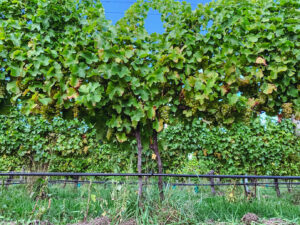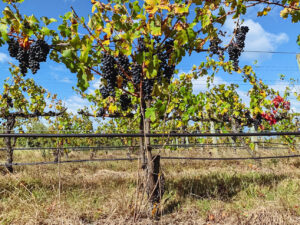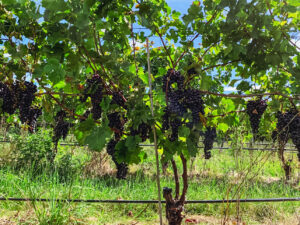Eline van Zijll de Jong (Linnaeus Ltd) and Mark Sosnowski (South Australian Research and Development Institute)
Grower reliance on remedial surgery to improve vine productivity and longevity is expected to increase as New Zealand’s vineyards continue to decline due to grapevine trunk diseases Botryosphaeria (BD) and Eutypa (ED) dieback.
These diseases are typically caused by spores that infect vines through pruning wounds. The fungi as they move down the trunk, destroy the woody tissue, disrupting the movement of water and nutrients. This leads to stunted shoot growth and death, decreased fruit yield and quality, and eventual vine death. Internal trunk staining and necrosis can be widespread by the time external dieback symptoms are visible.
Remedial surgery is being used to manage trunk disease in the absence of any curative treatments. This practice seeks to “renew” and extend the life of infected vines by removing the diseased trunk above the graft union and growing a new shoot to replace the old trunk. Because the established root system is retained, remediation is usually more cost-effective for growers than replacement. Efficacy is dependent on the removal of infected wood and recovery of watershoots.
A current project from the Vineyard Ecosystems Programme is developing best practice guidance for managing trunk disease using remedial surgery. Grower practices are being improved based on new findings on the progression of disease and distribution of pathogens, and the recovery, health and productivity of vines following remedial surgery.
About the trials

Remediated Sauvignon Blanc vine 3 years after surgery
Three trials were established in 2019, in mature commercial vineyard blocks that ranged from 18-21 years of age. One trial occurs in an organic block of Sauvignon Blanc in Marlborough, and the other two in conventional Cabernet Sauvignon and Merlot blocks in Hawke’s Bay.
In each trial, remedial surgery is performed in winter and spring over five years. Data is being collected on the progression of trunk disease and recovery of watershoots, and crop yields over time as well as on the distribution of trunk pathogens in existing and new trunks. Reworked vines are being compared in each trial against untreated controls.
Insights from vineyard trials
Assessment of disease in the trials over the past four years has demonstrated that not only the canopy but also the trunks of vines need to be examined by growers internally for symptoms to determine when to intervene. External dieback symptoms in the canopy are more difficult to track in cane-pruned vines than spur-pruned vines because the disease can be masked by the frequent replacement of canes and spurs with cane-pruning.

Fruit on a Sauvignon Blanc vine 3 years after surgery
In contrast to the spur-pruned Cabernet Sauvignon and Merlot trials, dieback symptoms did not change significantly in the cane-pruned Sauvignon Blanc trial even though internal wood staining symptoms in the lower trunks increased significantly. The number of vines that need to be examined internally depends on the extent of disease in the trunk and the acceptable margin of error. In a Sauvignon Blanc block where half of the vines have staining in the lower trunk, at least one row of 100 vines would be required.
Extensive molecular diagnostic testing of Sauvignon Blanc, Cabernet Sauvignon and Merlot trunks from the trials have found that both BD and ED pathogens can move well in advance of the staining, sometimes over distances of >200 mm. This means that growers need to make remedial surgery cuts as low as practical on the trunk to improve chances of removing the disease, taking into consideration the occurrence of bud sites and natural dieback of the wood. Early intervention when staining is further up the trunk is strongly recommended to enhance efficacy.

Fruit on a Cabernet Sauvignon vine 3 years after surgery
In areas where vineyards are not exposed to late frosts, growers can be confident that the timing of cuts does not affect vine recovery from remedial surgery. Over the past four years, remedial surgery has been carried out in both winter and early spring in the trials and no differences were recorded in the recovery of Sauvignon Blanc, Cabernet Sauvignon and Merlot vines based on the timing of cuts. There was often more sap flow from the remedial cut site in vines cut in spring than in winter, and sometimes a second application of wound protection was required. That said, delaying remedial surgery until spring may improve recoveries in vineyards prone to late frosts because differences in shoot length early in the season suggest that buds push earlier in vines cut in winter than in spring.
Disease data collected from the trials highlights the importance of growers not delaying intervention because this can reduce vine recoveries following remedial surgery. A significant increase was observed in disease in the lower trunks of Sauvignon Blanc, Cabernet Sauvignon and Merlot over four years and in the Sauvignon Blanc and Cabernet Sauvignon, there was a decline in vine recoveries the more severe wood staining symptoms were in lower trunk. In the Merlot, where vine recoveries were high because the vines produced ample watershoots, early intervention remains important for the successful removal of infected wood.

Fruit on a Merlot vine 3 years after surgery
Yield data collected from the trials is beginning to quantify the cost of trunk disease on vine productivity and how this cost at least be reduced by remedial surgery. Yields in the untreated controls in the Sauvignon Blanc, Cabernet Sauvignon and Merlot trials have declined significantly over the past four years. In contrast, the yield in remediated vines continues to improve and for those reworked in the first year of the trial, the yield has already surpassed the control. There is also evidence that wine quality has improved, at least in Sauvignon Blanc, where wines produced by remediated vines had in comparison to the control, higher levels of the desirable distinctive green and grassy aroma, 2-methoxy-3-iso-butylpyrazine (IBMP).
Presently there are no signs of trunk disease in the remediated vines, but the long-term life of these vines remains to be determined.
Further research
Valuable data has been collected from the trials in Sauvignon Blanc, Cabernet Sauvignon and Merlot that is already informing best practice recommendations. In the remaining year of the project, data will continue to be collected from the trials on the progression of disease in the trunks and the recovery, health and productivity of vines following remedial surgery. Of particular focus will be understanding the effect of internal trunk staining at the time of remedial surgery on the risk of pathogen transmission and the performance of vines. This data will provide growers with more decision-making support on whether to rework or replant vineyard blocks.

















